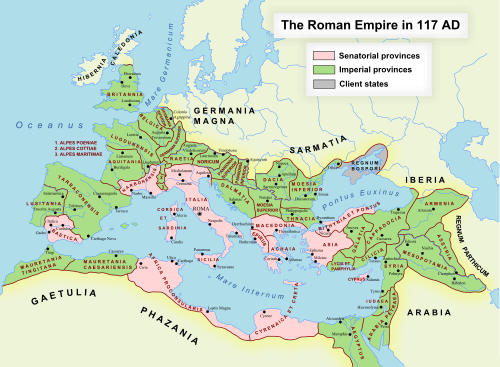Corsica and Sardinia
| Provincia Corsica et Sardinia | |||||
| Province of the Roman Empire | |||||
| |||||
.svg.png) | |||||
| Capital | Carales 39°15′N 09°03′E / 39.250°N 9.050°ECoordinates: 39°15′N 09°03′E / 39.250°N 9.050°E | ||||
| History | |||||
| • | Roman annexation | 238 BC | |||
| • | Capture by Vandals | 455 AD | |||
| Today part of | | ||||
The Province of Corsica and Sardinia (Latin: Provincia Corsica et Sardinia) was an ancient Roman province including the islands of Corsica and Sardinia.
Pre-Roman times

The Nuragic civilization flourished in Sardinia from 1800 to 500 BC. The ancient Sardinians, also known as Nuragics, traded with many different Mediterranean peoples during the Bronze Age and early Iron Age, especially with the Myceneans and Cypriots, building also many coastal settlements (like Nora and Tharros) and the characteristic tower buildings the island is known for, the nuraghes. A similar civilization also developed in Southern Corsica, where several torri were built. Later the Phoenicians establish several commercial stations in Corsica and Sardinia. After the Phoenicians, there arrived the Greeks, who also established their colonies. The Carthaginians (Phoenician colony), with the help of the Etruscans, conquered the Greek colony of Alalia, on Corsica in 535 BC. After Corsica, even Sardinia came under control of the Carthaginians.
Obtaining the province
Even though Rome had drawn up an earlier treaty with Carthage following the First Punic War, a complete disregard to this agreement led them to forcibly annex Corsica and Sardinia during the Mercenary War.[1] In 238 BC, the Carthaginians, accepting defeat in the First Punic War, surrendered Corsica and Sardinia, which together became a province of Rome.[2] This marked the beginning of Roman domination in the Western Mediterranean. The Romans ruled this area for 694 years.
Roman opinion of the province
Throughout this rule, Rome maintained an objective relationship with the province. The coastal regions of both islands were settled by Romans and adopted the Latin language and culture; however, the interior areas of Corsica and Sardinia resisted the Romans. A variety of revolts and uprisings occurred: however, since the interior areas were densely forested, the Romans avoided them and set them aside as the “land of the barbarians”.[3] Overall, Corsica and Sardinia became trivial gains compared to the Roman Empire's Eastern gains. The Romans regarded both the islands and their people as backward [citation needed] and unhealthy. From Corsica, the Romans did not receive much spoil nor were the prisoners willing to bow to foreign rule, and to learn anything Roman. It was said that “whoever has bought one (Corsican) regrets the waste of his money”.[3] Same goes for Sardinians, who acquired an infamous reputation for being untrustworhty and killing their master if they had a chance. Since the Sardinian captives were flooding the Roman slave market, the proverb Sardi venales ("Sardinians for cheap") became in fact an everyday Latin expression to indicate anything worthless, as Livius reported. Cicero referred to Sardinians as "every one worse than his fellow" (alius alio nequior)[4] and to their rebels in the highlands, that kept fighting the Romans in guerrilla-style, as "thieves with rough wool cloaks" (latrones mastrucati).[5]
Relationship to Rome
Corsica and Sardinia ended up playing an important role in the happenings of the Empire. Sardinia provided much of the grain supply during the time of the Roman Republic. Corsica provided wax to the empire, as that was all that could be found on the island.
The islands also indirectly contributed to the demise of the Roman Republic. Gaius Marius and Lucius Cornelius Sulla Felix settled their veterans on Corsica and used the islands' grain supply to support their war efforts. Julius Caesar had Sardinia occupied by his delegates and gained control of the grain supply. This supply of grain fed his army and ensured their victory in the civil war of 49 BC. Within the second triumvirate, Octavian received the islands as part of his share and used its grain supply to feed his armies against Brutus and Cassius.[3]
Corsica and Sardinia also came to be recognized as a place of exile. C. Cassius Longinus, the lawyer accused of conspiracy by Nero was sent to the province, while Anicentus, murderer of the elder Agrippina was sent to Sardinia. Many Jews and Christians were also sent to the islands under Tiberius.[3]
References
- ↑ Caven, Brian (1980). The Punic Wars. New York: St. Martin’s Press.
- ↑ Bagnall, Nigel (1990). The Punic Wars: Rome, Carthage, and the Struggle for the Mediterranean. New York: St. Martin’s Press.
- 1 2 3 4 Chapot, Victor (2004). The Roman World. London: Kegan Paul. pp. 140–150.
- ↑ Epistolae ad familiares, VII, 24, 2
- ↑ "Cicero: Pro Scauro".
